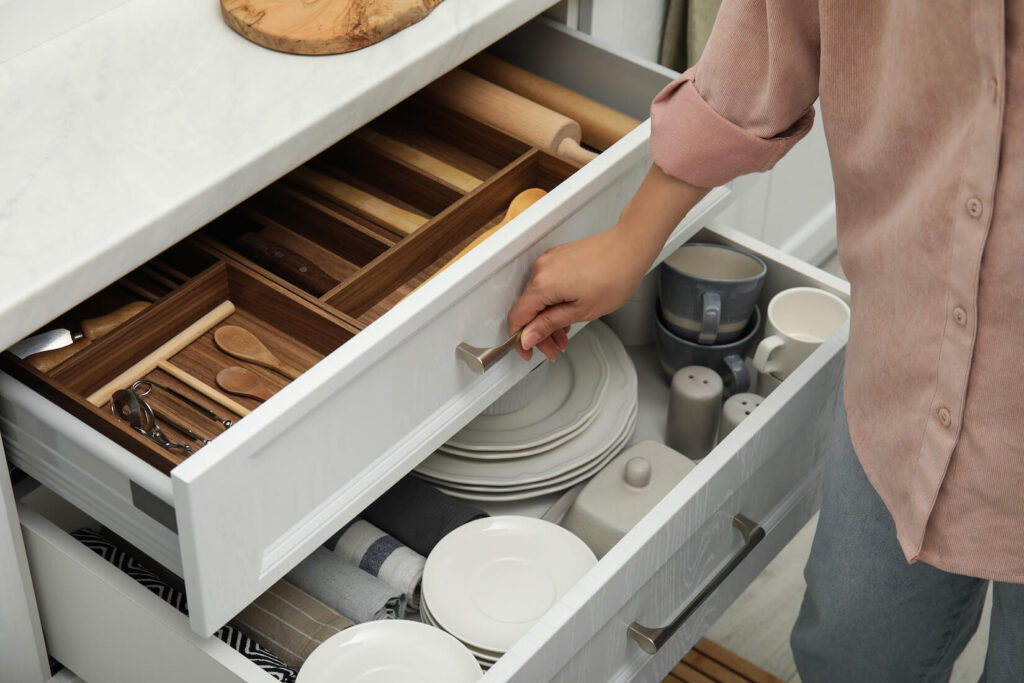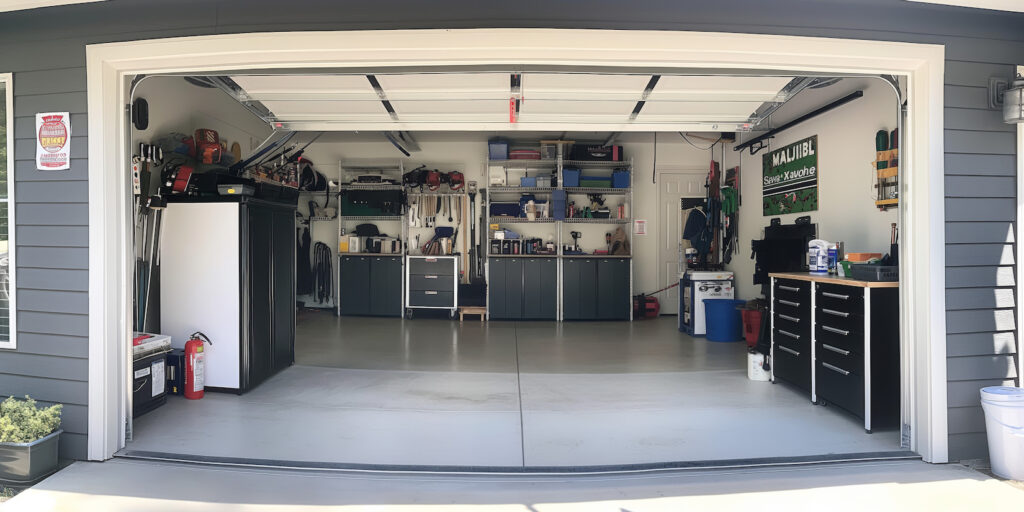Organizing your kitchen can seem daunting, but you’ll find that it’s not that hard — trust us, we’ve done it thousands of times! All you need to do is set aside a few hours to tackle this project, and you’ll benefit from having organized kitchen cabinets, making it easier to find whatever you need. Below, we’ll review our proven five-step process for cleaning and organizing kitchen cabinets. We’ll also cover additional kitchen organizing tips to streamline your kitchen.
1. Clear Out Your Cabinets
Start by pulling everything out from the cabinets and drawers. All of the bowls, plates, cups, silverware, pots, pans — literally all of it. Pulling everything out of the space makes it easier to see which items belong in your kitchen and which are just adding to the clutter of your drawers and cabinets. Don’t be nervous about getting it all out; the process always looks worse before it gets better!
2. Categorize Is Key
While you pull everything out of the drawers and cabinets, put all the items into categorized groups and discard any trash. This means putting all the plates together, all the pots and pans together, and so on, until everything is in groups with similar items. By grouping like-items together, you’ll easily see what you have or don’t have. You’ll also see what you have too much of, which should make downsizing easier (but more on that next!)
3. Keep, Trash, Donate
With everything categorized, it’s time to look through each pile and decide what you want to keep and what can go. Items you frequently use should stick around, but you might consider getting rid of duplicates. Whether it’s silverware, cooking utensils, small appliances, or one-use kitchen tools, be honest with yourself about what you really use. Everything else can be donated or put in the trash. Lesser used items can be stored in “less valuable real estate” in your kitchen.
4. Clean Your Kitchen Cabinets
With nothing left in your cabinets, this is the perfect time to wipe down those spaces. Start by dusting off the highest cabinets. Then, move into the cabinets and drawers, wiping the inside and outside. You can also spray disinfectant on all of the handles of the cabinets and drawers.
5. Setting up the System
With clean kitchen cabinets, it’s now time to put everything back. Storing similar items in drawers and cabinets is a good starting point, but there are ways to further streamline your kitchen.
These are our recommendations on where to put away items in your kitchen cabinets:
Cooking Spoons, Spatulas, etc.: Items like spatulas and cooking spoons should be kept in a drawer closest to the stove, or you can put them on your countertop in a decorative utensil holder. When putting items back into drawers, think about what you use most often and place those in the easiest-to-reach drawers.
Other Cooking Utensils: Other items you may want in the most accessible drawers are measuring cups and spoons, can openers, silverware, and any other small items you use most often. When placing items in the cabinets, consider who uses them and how often they are used.
Kids Items: Items used mostly by kids are best placed in a low drawer so they can easily reach what they need — this can create autonomy for you kids to put things away!
Pots and Pans: Storing away pots and pans can become annoying with all of the different shapes, sizes, and lids. A great way to organize all those utensils is to install a pot and pan organizer in a cabinet – it organizes them like a file, so you can easily grab the handle!
Large Cooking Equipment: If you have deeper cabinets, it can be helpful to create a “small appliance cabinet.” Every cook is different, so it’s best to place lesser-used small appliances behind those that are more frequently used!
Seasonal Items: Since seasonal items are used only once a year, it’s best to store them in storage for the rest of the year. Seasonal items such as Christmas cookie cutters and Thanksgiving serving dishes can be kept in clear, labeled storage containers. If you have many seasonal items for different holidays, you might want to store them in separate containers. If you have space in your kitchen, you can also have a section off to the side or higher up for all your holiday dishes!
Additional Tips
Use drawer organizers: Small bins in your drawers are essential for storing small items or keeping your categories clear. Small items like potato peelers or can openers won’t shift around in the drawer, making it easier to find and store them.
Label things: Labeling will save you so much time in the long run. It will make it easier to find exactly what you need and eliminate the guesswork of putting items back. Label makers and similar products are useful for this, but you can also use a Sharpie and labels or some form of tape!
Re-Home Non-Kitchen Items: For any items that were in your kitchen drawers and cabinets at the start of the process but don’t actually belong there, take the time now to re-home those items.
Don’t Have a “Junk Drawer”: If there’s one thing you should avoid having in your kitchen, it is a junk drawer. We like to call a well-organized “junk drawer” a utility drawer. It’s convenient to be able to quickly grab a pen, tape, scissors, or batteries from this space — but keeping things categorized with drawer organizers will be key!
Organize Your Kitchen Cabinets With Clutterless Home Solutions
Organizing and cleaning your kitchen is easier than it sounds. When you break it down into digestible steps, you can knock this out in a day or over a weekend. Just remember to get rid of the items you don’t want or need anymore. Less clutter will help your kitchen cabinets stay organized for a long time.
When you don’t have time to take on organizing projects, leave it to the experts. At Clutterless Home Solutions, we specialize in organizing your home. Whether it’s the kitchen cabinets, a pantry, or a garage, we can help you create efficient systems that are easy to maintain. Give us a call at (720) 770-2646 or visit our website to book an appointment and get started on your journey to an easier-to-organize, enjoyable home.



